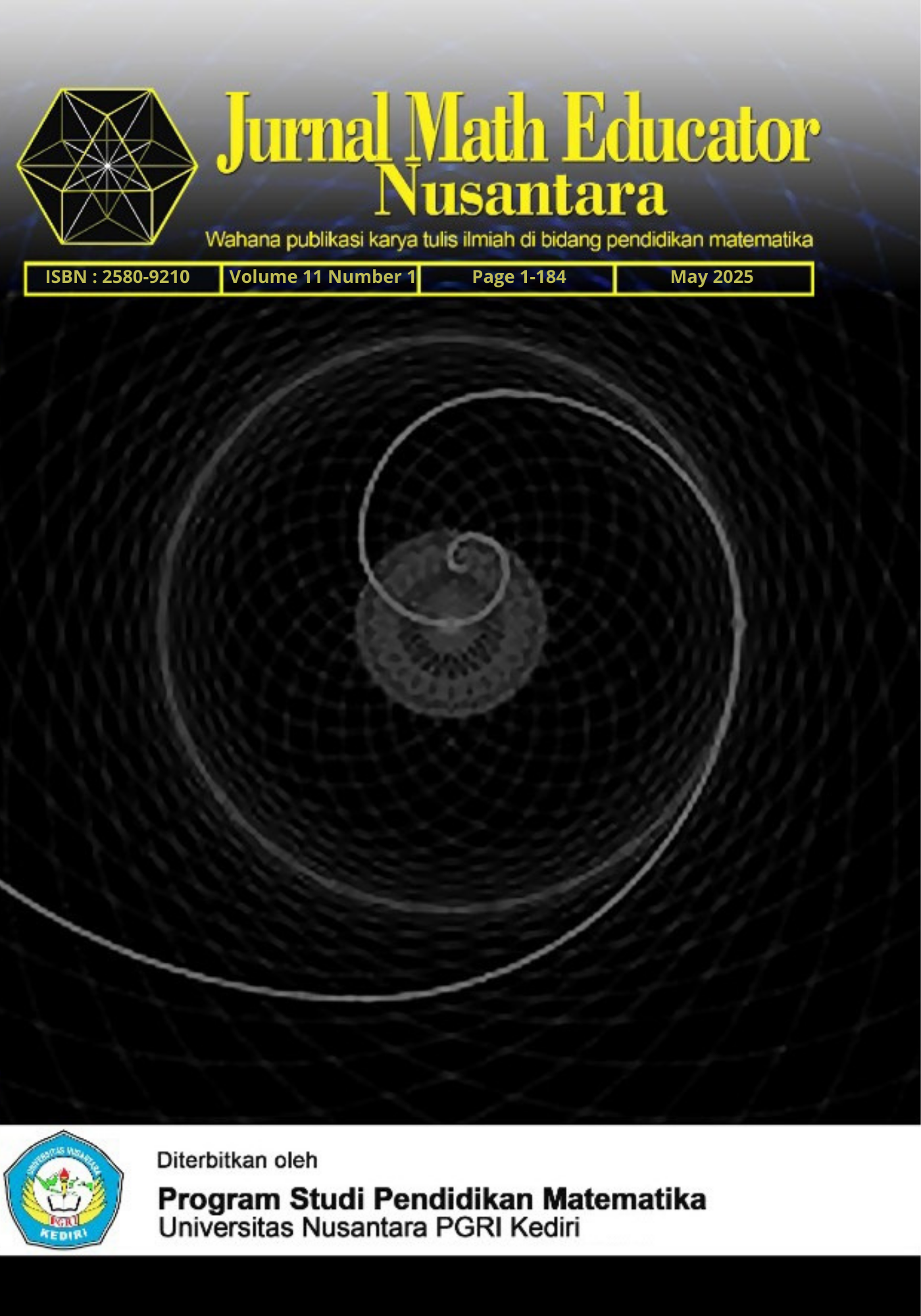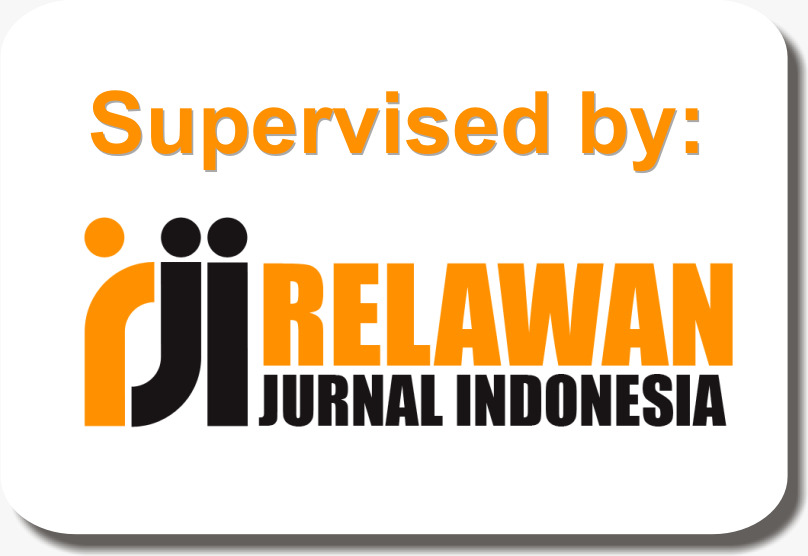Enhancing PISA-like mathematical literacy through deep learning assisted by mathos ai for junior high school students
DOI:
https://doi.org/10.29407/jmen.v11i1.25109Keywords:
Mathematical Literacy, Like-PISA, Deep learning, Mathos AI, Design ResearchAbstract
Based on PISA, Indonesian students' mathematical literacy skills are very low. This study investigates the effectiveness of Mathos AI-assisted deep learning design in improving PISA-like mathematical literacy among junior high school students. Using design research methodology with validation studies approach. Data were collected through pre-test and post-test, classroom observation, interviews, and analysis of student work. The findings revealed significant improvements in students' mathematical literacy, with positive impacts on their motivation and engagement. The integration of Mathos AI facilitates personalized learning and provides valuable insights into students' learning processes. This study contributes to the growing literature on AI-driven educational interventions, which offer practical implications for improving mathematical literacy in real-world classroom settings. The conclusion of this study is that Mathos AI-assisted deep learning is able to improve PISA-like mathematical literacy skills among junior high school students. The integration of AI-based tools in mathematics education can result in improved learning outcomes and student engagement. Further research is needed to explore the long-term effects of AI-based interventions and develop best practices for their implementation.
References
Abukhalaf, S., Charles, T., & Hill, C. (2024). The Metaverse as a Virtual Learning Space: Perceptions from the UAE. Journal of Ecohumanism, 3(5), 1037–1052. https://doi.org/10.62754/joe.v3i5.3954
Bransford, J. D., Brown, A. L., & Cocking, R. R. (2000). How people learn (Vol. 11). DC: National academy press. (Washington)
Ekawati, R., Masriyah, R., H, A., Prawoto, B. P., Prahmana, R. C. I., & Lin, F. L. (2022). Developing a Constructive Conceptual Framework of a Pre-Service Mathematics Teachers'. Content Knowledge Instrument on Space and Shape. Mathematics, 10(1). https://doi.org/10.3390/math10010137
Feng, Z. (2023). Formal Analysis for Natural Language Processing: A Handbook. In Formal Analysis for Natural Language Processing: A Handbook. Springer Nature. https://doi.org/10.1007/978-981-16-5172-4
Friansah, D., Zulkardi, Z., Susanti, E., & Nusantara, S. (2024). Rancangan Hypothetical Learning Trajectory ( HLT ) Menggunakan Konteks Perubahan Iklim untuk Melatih Kemampuan Literasi Statistik. SJME (Supremum Journal of Mathematics Education, 08(01), 59–71. https://doi.org/10.35706/sjme.v8i1.10440
Garcia, M. L. B., Gaylo, D. N., & Vistro-Yu, C. P. (2024). Writing PISA-Like Mathematics Items: The Case of Tertiary Mathematics Instructors from a State University in the Philippines. European Journal of Educational Research, 13(4), 1441–1453. https://doi.org/10.12973/eu-jer.13.4.1441
Hattie, J. (2008). Visible learning: A synthesis of over 800 meta-analyses relating to achievement (1st Edition ed.). https://doi.org/10.4324/9780203887332 (Routledge)
Hernawati, P. L., Prijambodo, C. K., & Wicaksono, A. (2024). Ethnomathematics studies according to the bishop in Chinese culture at the Sanggar Agung Chinese temple as basic literacy in mathematics. AIP Conference Proceedings, 3201(ue 1)). https://doi.org/10.1063/5.0230758
Hikamudin, E., Riyadi, A. R., Aryanti, P., D, N., P, & Gofur, R. (2023). Improving Elementary School Students' Understanding of Literacy and Numeracy Through Digital Applications. MIMBAR PGSD Undiksha, 11(3), 462–467. https://doi.org/10.23887/jjpgsd.v11i3.64018
Humaira, D. F., & Putri, R. I. I. (2024). Student Critical Thinking Ability in Solving PISA-Like Mathematics Problem in The Context of Palembang Tourism "Bait Al-Quran Al-Akbar. AIP Conference Proceedings, 3052(ue 1)). https://doi.org/10.1063/5.0201017
Imane, O., Mohamed, A., Lazhar, R. F., Hama, S., Elhadj, B., & Conci, A. (2024). LAMIS-DMDB: A new full field digital mammography database for breast cancer AI-CAD researches. Biomedical Signal Processing and Control, 90. https://doi.org/10.1016/j.bspc.2023.105823
Ingram, J., Lee, G., & Stiff, J. (2024, 2024). MATHEMATICAL REASONING AND PROBLEM-SOLVING IN PISA 2022 HOW DO PERFORMANCE PROFILES VARY ACROSS COUNTRIES?, https://www.scopus.com/inward/record.uri?eid=2-s2.0-85200229965&partnerID=40&md5=7140ab704deceda27fa3b1f3ef97b786
Isnaintri, E., & Hepsy, N. (2023). Development of Numeracy Literacy Instrument in the Context of Local Wisdom in Pandeglang at the Madrasah Tsanawiyah. Phenomenon : Jurnal Pendidikan MIPA, 13(1), 111–131. https://doi.org/10.21580/phen.2023.13.1.16783
Kadijević, M., & Vlahović, N. (2015). The impact of interactive multimedia on students’ learning outcomes and attitudes. Computers in Human Behavior, 49(1), 503–511.
Karaca, Y., Baleanu, D., Moonis, M., Zhang, Y. D., & Gervasi, O. (2023). IV-III-II-I SERIES FRACTALS-FRACTIONAL AI-BASED ANALYSES AND APPLICATIONS TO COMPLEX SYSTEMS. Fractals, 31(10). https://doi.org/10.1142/S0218348X2302005X
Khine, M. S., Liu, Y., Pallipuram, V. K., & Afari, E. (2024). A Machine-Learning Approach to Predicting the Achievement of Australian Students Using School Climate; Learner Characteristics; and Economic, Social, and Cultural Status. Education Sciences, 14(12). https://doi.org/10.3390/educsci14121350
Koedinger, K. R., Anderson, J. R., Hadley, W. H., & Mark, M. A. (1997). Intelligent Tutoring Goes To School in the Big City. International Journal of Artificial Intelligence in Education, 8, 30-43. https://telearn.hal.science/hal-00197383
Lee, S. G., Lee, J. H., Lim, D. S., & Park, D. (2024). Teaching mathematics for AI with ChatGPT and GPT-4 Omni. Research in Mathematical. https://koreascience.kr/article/JAKO202406463181117.page
Liu, J., Lin, G., Mei, H., Yang, F., & Tai, Y. (2025). Enhancing vulnerability detection efficiency: An exploration of light-weight LLMs with hybrid code features. Journal of Information Security and Applications, 88. https://doi.org/10.1016/j.jisa.2024.103925
Liu, S.-H., & Wu, C.-H. (2019). Exploring the factors influencing students’ acceptance of mobile learning: An application of the UTAUT model. Universal Access in the Information Society, 18(4), 865–877.
Liu, Y., Guo, J., Benes, B., Deussen, O., Zhang, X., & Huang, H. (2021). TreePartNet: Neural Decomposition of Point Clouds for 3D Tree Reconstruction. ACM Transactions on Graphics, 40(6). https://doi.org/10.1145/3478513.3480486
Lu, P., Bansal, H., Xia, T., Liu, J., Li, C., Hajishirzi, H., Cheng, H., Chang, K. W., Galley, M., & Gao, J. (2024, 2024). MATHVISTA EVALUATING MATHEMATICAL REASONING OF FOUNDATION MODELS IN VISUAL CONTEXTS. 12th International Conference on Learning Representations, ICLR 2024, https://www.scopus.com/inward/record.uri?eid=2-s2.0-85200546163&partnerID=40&md5=8047130c306c629e905d3ba89fdbd483
Ma, Y., Zhou, F., Wen, G., Gen, H., Huang, R., Wu, Q., & Pei, L. (2022). A 3d lidar reconstruction approach for vegetation detection in power transmission networks. International Archives of the Photogrammetry, Remote Sensing and Spatial Information Sciences - ISPRS Archives, 46(3/W1-2022), 141–148. https://doi.org/10.5194/isprs-archives-XLVI-3-W1-2022-141-2022
Mayer, R. E. (2009). Multimedia learning (2nd ed.) (Vol. 2). Cambridge University Press. (Inggris)
Mishra, P., & Koehler, M. J. (2006). Technological pedagogical content knowledge: A framework for teacher knowledge. Teachers college record 108(6), 1011054. https://doi.org/10.1111/j.1467-9620.2006.00684
Nugroho, K., Izwanto, E., Widada, W., Falaq, A., Anggoro, D., Herawaty, D., Jumri, R., Dewarif, S., & Aggoro, T. (2023). The Relationship among Self-Efficacy. Mathematical Concepts Understanding , Creative Thinking Skills , Mathematical Problem-Solving Skills , and Mathematics Learning Outcomes. EDUMATIKA: Jurnal Riset Pendidikan Matematika, 6(2). https://doi.org/10.32939/ejrpm.v6i2.3169
O.e.c.d. (2019). PISA 2018 Assessment and Analytical Framework. https://doi.org/10.1787/b25efab8-en
O.e.c.d. (2023). PISA 2022 Results Factsheets Indonesia PUBE. https://oecdch.art/a40de1dbaf/C108.
Öz, E., Bulut, O., Cellat, Z. F., & Yürekli, H. (2024). Stacking: An ensemble learning approach to predict student performance in PISA 2022. Education and Information Technologies. https://doi.org/10.1007/s10639-024-13110-2
Payadnya, I. P. A. A., Prahmana, R. C. I., Lo, J. J., Noviyanti, P. L., & Atmaja, I. M. D. (2023). Designing area of circle learning trajectory based on "what-if" questions to support students' higher-order thinking skills. Journal on Mathematics Education, 14(4), 757–780. https://doi.org/10.22342/jme.v14i4.pp757-780
Plomp, T., & Nieveen, N. (2013). Educational Design Research. Educational Design Research, 1–206. https://doi.org/10.1007/978-1-4614-3185-5_11
Ranjan, R., Partl, R., Erhart, R., Kurup, N., & Schnidar, H. (2021). The mathematics of erythema: Development of machine learning models for artificial intelligence assisted measurement and severity scoring of radiation induced dermatitis. Computers in Biology and Medicine, 139. https://doi.org/10.1016/j.compbiomed.2021.104952
Rott, B. (2021). Problem solving in mathematics education. Research in Mathematics Education, 23(ue 2)). https://doi.org/10.1080/14794802.2020.1731577
Santos, A. M., Moura, F. R. T., Alves, A. V. N., Pinto, L. V. L., Costa, F. A. R., Santos Oliveira, W., Cardoso, D. L., & Rocha Seruffo, M. C. (2023, 2023). Artificial Intelligence in Education 5.0: a methodology for three-dimensional geometric shape classification for an educational tool 2023 IEEE Latin American Conference on Computational Intelligence, LA-CCI 2023, https://doi.org/10.1109/LA-CCI58595.2023.10409430
http://dx.doi.org/10.1109/LA-CCI58595.2023.10409430
Sepriliani, S. P. (2023). Development of PISA-like Activities using the Inquiry-based Learning Model and the Context of Religious Holidays during the Pandemic. Mathematics Education Journal, 17(1), 37–54. https://doi.org/10.22342/jpm.17.1.17765.37-54
Svyatkovskiy, A., Fu, S., Zhao, Y., & Sundaresan, N. (2019, 2019). Pythia: AI-assisted code completion system Proceedings of the ACM SIGKDD International Conference on Knowledge Discovery and Data Mining, https://doi.org/10.1145/3292500.3330699
http://dx.doi.org/10.1145/3292500.3330699
Thomson, S., Hillman, K., & Bortoli, L. (2013). A Teacher 's Guide to PISA Mathematical Literacy. https://www.acer.org/files/PISA_Thematic_Report_-_Maths_-_web.pdf
Waluya, S. B., & Nugroho, S. E. (2018). Analysis mathematical literacy skills in terms of the students' metacognition on PISA-CPS model. Journal of Physics: Conference Series, 983(1). https://doi.org/10.1088/1742-6596/983/1/012151
Wesna, M. (2021). Mathematical literacy ability in terms of the independent learning students on reciprocal teaching learning models with approaching RME assisted by google classroom. Journal of Physics: Conference Series, 1918(4). https://doi.org/10.1088/1742-6596/1918/4/042040
Widada, W., Herawaty, D., Nugroho, K. U. Z., & Anggoro, A. F. D. (2021). Augmented Reality assisted by GeoGebra 3-D for geometry learning. Journal of Physics: Conference Series, 1731(1). https://doi.org/10.1088/1742-6596/1731/1/012034
Zhu, L., You, H., Hong, M., & Fang, Z. (2025). Predictive insights into U.S. students' mathematics performance on PISA 2022 using ensemble tree-based machine learning models. International Journal of Educational Research, 130. https://doi.org/10.1016/j.ijer.2025.102537
Zimmerman, B. J. (2000). Self-Efficacy: An Essential Motive to Learn. Contemporary Educational Psychology, 25(1), 82-91. https://doi.org/https://doi.org/10.1006/ceps.1999.1016
Zulkardi, N., S, D., & Putri, R. I. I. (2021). Designing PISA-like task on uncertainty and data using Covid-19 context. Journal of Physics: Conference Series, 1722(1), 0–6. https://doi.org/10.1088/1742-6596/1722/1/012102.
Downloads
Published
Issue
Section
License
Copyright (c) 2025 Wahyu Widada, Khathibul Umam Zaid Nugroho, Masri Masri, Abdurrobbil Falaq Dwi Anggoro, Dewi Herawaty, Rahmat Jumri, Shadaqnas Dewarif Tri Anggoro

This work is licensed under a Creative Commons Attribution 4.0 International License.
Authors who publish with this journal agree to the following terms:
- Copyright on any article is retained by the author(s).
- The author grants the journal, the right of first publication with the work simultaneously licensed under a Creative Commons Attribution License that allows others to share the work with an acknowledgment of the work’s authorship and initial publication in this journal.
- Authors are able to enter into separate, additional contractual arrangements for the non-exclusive distribution of the journal’s published version of the work (e.g., post it to an institutional repository or publish it in a book), with an acknowledgment of its initial publication in this journal.
- Authors are permitted and encouraged to post their work online (e.g., in institutional repositories or on their website) prior to and during the submission process, as it can lead to productive exchanges, as well as earlier and greater citation of published work.
- The article and any associated published material is distributed under the Creative Commons Attribution-ShareAlike 4.0 International License
















